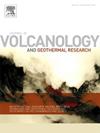链接2013-17年墨西哥Volcán de Colima火山喷发期间的监测数据和岩浆补给的时间尺度
IF 2.4
3区 地球科学
Q2 GEOSCIENCES, MULTIDISCIPLINARY
Journal of Volcanology and Geothermal Research
Pub Date : 2025-01-31
DOI:10.1016/j.jvolgeores.2025.108285
引用次数: 0
摘要
通过对2013-17间纪喷发期喷出的辉石晶体进行扩散模拟,计算了Volcán de Colima地下基性岩浆补给的时间尺度。结果表明,小体积基性岩浆的注入是周期性的、短暂的,在喷发前仅在管道系统中停留几周到几个月。2013年10月至2014年4月、2014年9月至2015年6月、2015年11月至2016年9月,在3年内至少发生了3次岩浆补给和混合。将这些时间尺度与火山连续地震监测和准连续气体监测资料进行了比较。在岩石学和监测资料中,各喷发阶段表现出不同的模式,表明存在复杂的混合喷发关系,这可能与补给事件的频率和数量以及岩浆储层的热状态有关。低频率或小体积的岩浆注入可能导致与监测数据的任何变化缺乏相关性。岩浆注入的高频率导致了补给事件与监测记录之间的强相关性,这可能有助于解释未来的监测数据。本文章由计算机程序翻译,如有差异,请以英文原文为准。
Linking monitoring data and timescales of mafic recharge during the 2013–17 eruption at Volcán de Colima, Mexico
Timescales of mafic magma recharge beneath Volcán de Colima have been calculated from diffusion modelling of reversely zoned pyroxene crystals erupted in the 2013–17 interplinian eruptive period. The results suggest that injections of low volume mafic magma are periodic and ephemeral, residing in the plumbing system for only weeks to months before eruption. At least three separate periods of magma recharge and mixing occurred within c. 3 years in October 2013–April 2014, September 2014–June 2015 and November 2015–September 2016. These timescales have been compared with the continuous seismic monitoring of the volcano and quasi-continuous gas monitoring data. Each eruptive phase shows different patterns between petrological and monitoring data, suggesting a complex mixing-eruption relationship, which may be related to the frequency and volume of recharge events, as well as the thermal state of the magma reservoir. Low frequency or low volumes of magma injection may result in a lack of correlation with any change in the monitoring data. High frequency of magma injections priming the magma reservoir results in a strong correlation between recharge events and monitoring record, which may be useful for interpreting future monitoring data.
求助全文
通过发布文献求助,成功后即可免费获取论文全文。
去求助
来源期刊
CiteScore
5.90
自引率
13.80%
发文量
183
审稿时长
19.7 weeks
期刊介绍:
An international research journal with focus on volcanic and geothermal processes and their impact on the environment and society.
Submission of papers covering the following aspects of volcanology and geothermal research are encouraged:
(1) Geological aspects of volcanic systems: volcano stratigraphy, structure and tectonic influence; eruptive history; evolution of volcanic landforms; eruption style and progress; dispersal patterns of lava and ash; analysis of real-time eruption observations.
(2) Geochemical and petrological aspects of volcanic rocks: magma genesis and evolution; crystallization; volatile compositions, solubility, and degassing; volcanic petrography and textural analysis.
(3) Hydrology, geochemistry and measurement of volcanic and hydrothermal fluids: volcanic gas emissions; fumaroles and springs; crater lakes; hydrothermal mineralization.
(4) Geophysical aspects of volcanic systems: physical properties of volcanic rocks and magmas; heat flow studies; volcano seismology, geodesy and remote sensing.
(5) Computational modeling and experimental simulation of magmatic and hydrothermal processes: eruption dynamics; magma transport and storage; plume dynamics and ash dispersal; lava flow dynamics; hydrothermal fluid flow; thermodynamics of aqueous fluids and melts.
(6) Volcano hazard and risk research: hazard zonation methodology, development of forecasting tools; assessment techniques for vulnerability and impact.

 求助内容:
求助内容: 应助结果提醒方式:
应助结果提醒方式:


